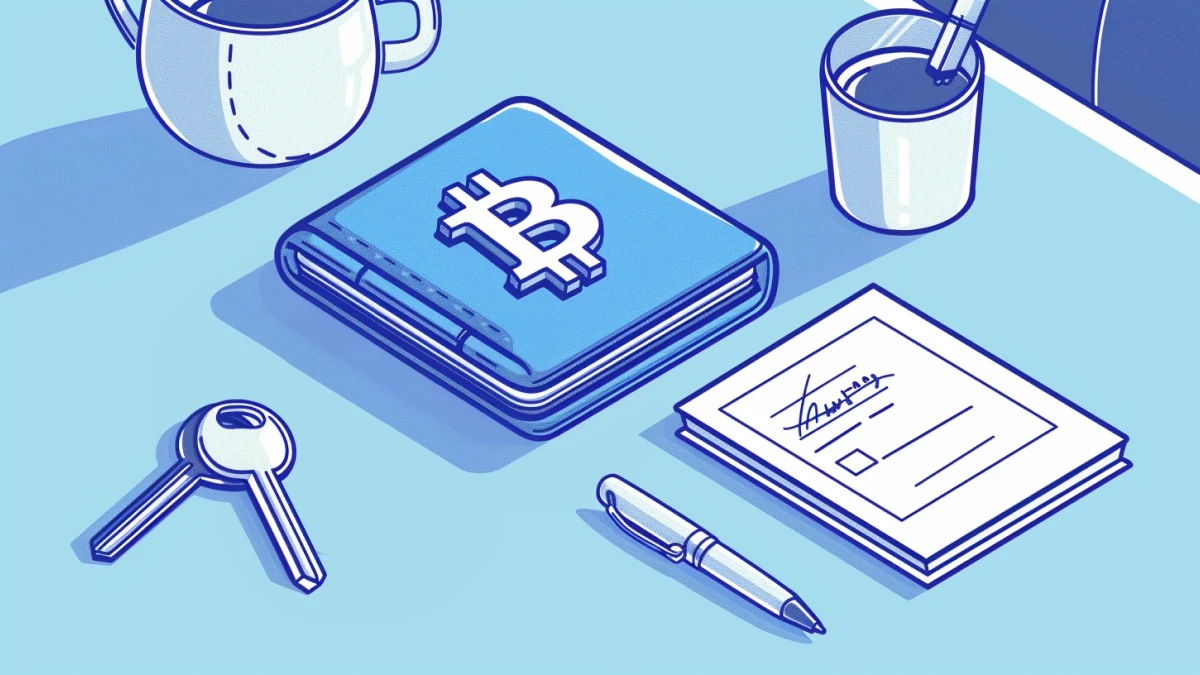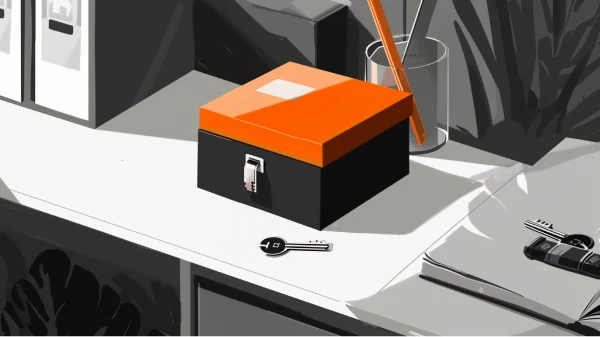Bitcoin addresses represent a destination on the Bitcoin blockchain where users can send and receive funds. Bitcoin addresses are a central point of activity along the network: all transactions pass through addresses and all funds “live” at these addresses.
At first, addresses may seem intimidating, or even random. But after reading through this guide, and getting some hands-on experience with Bitcoin addresses, you will gain the confidence to send and receive transactions like a pro!
This article explains what Bitcoin addresses are, why the Bitcoin network uses addresses instead of accounts, where users can get their own Bitcoin addresses, the different types of addresses, FAQs on Bitcoin addresses, as well as demonstrations of where Bitcoin addresses can be found in different wallets.
What Is a Bitcoin Address?
A Bitcoin address is a string of letters and numbers that represents a destination to which bitcoin can be sent. By default, only the person who generated a Bitcoin address can access the funds on it. Bitcoin addresses are derived from, and mathematically connected to a particular user’s public key – but are displayed in a more shareable manner than a full-length public key.
Wallets are used to create and manage Bitcoin addresses. These wallets are software applications that can be installed on a mobile phone, a laptop, or a desktop. They are the main interface for a user to interact with the Bitcoin network and they can manage many addresses to send and receive bitcoin. We will dive into this process later on.
Bitcoin Address Usage
Bitcoin uses addresses to easily exchange ownership of bitcoin. The Bitcoin software tracks which addresses have funds on them while respecting the privacy of the users. No personally identifiable information is required for users to transact on the Bitcoin network.
If Bitcoin used accounts instead of addresses, then everyone who stores the entire history of transactions (called the blockchain) could easily see a user’s entire history of transactions. However, by using a new address for each transaction, it is much more difficult for anyone to track an individual user’s transaction history.
Bitcoin addresses have funds stored on them, which are called UTXOs, “Unspent Transaction Outputs.” Computers along the Bitcoin network, called nodes, maintain a list of these UTXOs. Whenever a new transaction is sent, any node can quickly verify if it is valid by checking if the sending Bitcoin address has funds stored on it. This handy list ensures nodes do not need to search the entire history of transactions each time.
Bitcoin’s accounting system may seem confusing at first, but it helps to think of Bitcoin addresses as lockboxes, UTXOs as coins stored in those lockboxes, and private keys as the keys to unlock the lockboxes.
In this analogy, if you wanted to send a peer some bitcoin, you would unlock a particular lockbox (Bitcoin address) with a corresponding private key and send those coins (UTXOs) to a lockbox that your peer controls. Conversely, receiving bitcoin would be as simple as providing a peer with some information about a lockbox that you control.
Where Can I Make a Bitcoin Address?
Bitcoin addresses are made in Bitcoin wallets. In order to make a Bitcoin address, all you have to do is download a wallet of your choice, and follow the instructions provided – we will cover some specific examples later on.
Note that wallet software does not store bitcoin, in fact, bitcoin never leaves the blockchain. So as long as users backup their wallets, any associated funds can be recovered using any wallet software, because wallets simply track funds across different addresses.
A Bitcoin wallet does not have just one address, it can generate as many addresses as you want. This is important because if a user always reused the same Bitcoin address, anyone would be able to track their finances. Instead, wallets are set up in such a way that your address always changes to help protect your privacy.
➤ Learn more about how Bitcoin wallets work.
Bitcoin Address Creation
The first step is to download and set up a wallet of your choice. Although the majority of wallets are free to download and use, there are many other considerations when choosing between wallets. If you are not sure where to start, we have a guide on choosing the right Bitcoin wallet. Once downloaded, installed, and properly backed up, the Bitcoin wallet handles the rest of the address-generation process.
Following the wallet setup process, you will have to navigate through its interface to the “receive” option – this is (generally) right next to the send option. Once you click receive, most wallets will show you a QR code and an alphanumeric Bitcoin address. You can share one of these with the sender. A QR code is most convenient for transactions in person, while the readable address is better for digital payments – though both the QR and alphanumeric string represent the same address.
The following sections will demonstrate how to find Bitcoin addresses in a wallet. To give a few practical examples, we will use Blockstream’s Green Wallet for mobile, Craig Raw’s Sparrow Wallet on desktop, and show you what it looks like in River’s own wallet.
We selected Blockstream’s Green Wallet because it has a very intuitive user interface, with plenty of additional features that advanced users can explore, too. Sparrow Wallet is a featureful, interoperable wallet application that can be used as a standalone wallet on desktop, or be connected to nearly any hardware wallet, and was designed to guide users toward Bitcoin custody best practices. There are many other wallet options out there that we would encourage you to explore.
Mobile Wallet Example - Blockstream’s Green Wallet
Green Wallet is a beginner-friendly wallet application that provides users with all the necessary information to send and receive bitcoin. Green wallet has been around for years, is battle-tested, and is customizable to suit the needs of all users.
After entering the previously specified PIN code, users will be shown the home screen below. On this screen, you will see the wallet’s name in the upper right corner, the balance of funds controlled by the wallet, the type of addresses generated by the wallet, and a list of past transactions.
In the bottom right corner of the home screen is a “receive” button – tap on this button to navigate to a page that displays your current receive address:
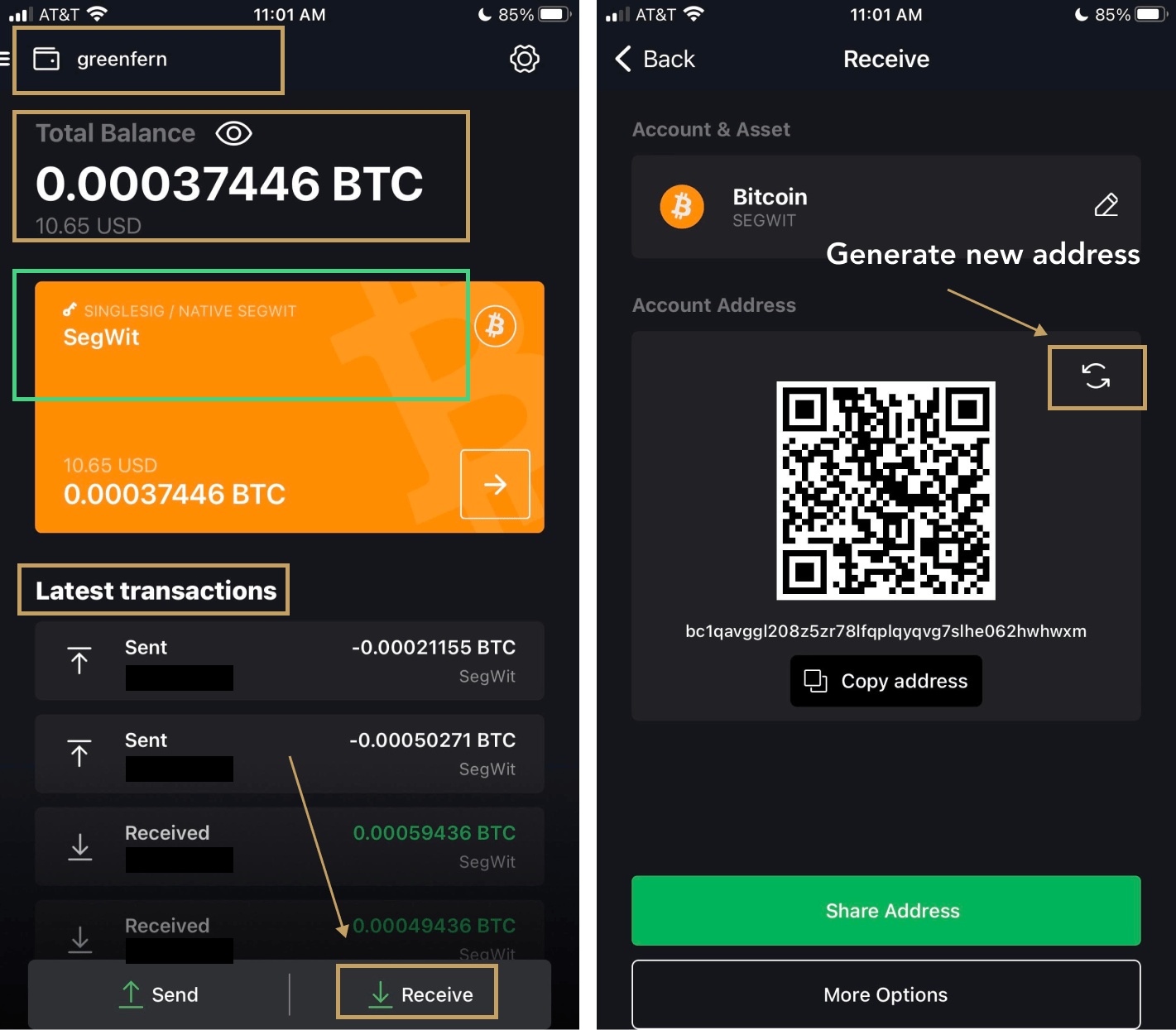
The receive screen contains the current Bitcoin address at which your wallet will receive funds. In addition, just to the right of the QR code is a button that instructs the wallet to generate a new address to receive funds – this feature can be used as many times as desired.
Blockstream’s team has published a video recently where they take you through a full self-custody Green wallet set up from beginning to end.
Desktop Wallet Example - Sparrow Wallet
Sparrow wallet is a desktop wallet that steers Bitcoin users towards privacy best practices when sending and receiving bitcoin. Its interface is intuitive, relatively beginner-friendly, and comes with a suite of extra features for power users.
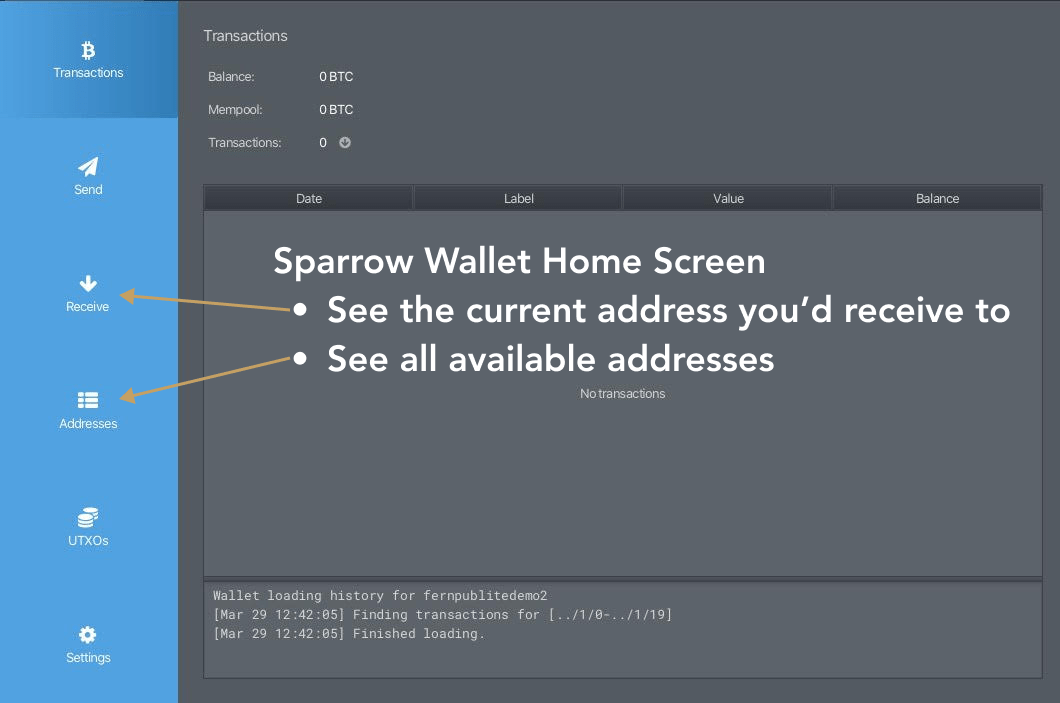
After inputting a previously specified passphrase, users will see the above home screen. The buttons on the sidebar to the left of the screen allow users to navigate to different features of the wallet. When a user clicks on the “receive” button, they will be redirected to the below screen:
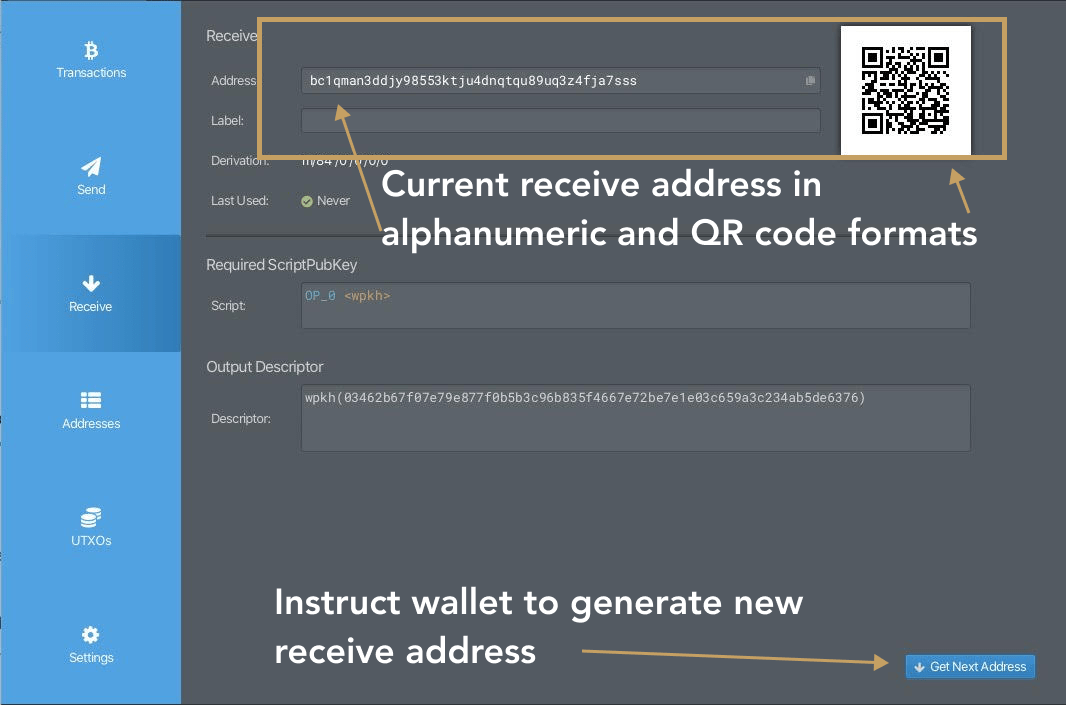
Regardless if the wallet is on desktop or mobile, most Bitcoin wallets will have similar features: an alphanumeric representation of the current receive address, a QR format of the same address, and an option to generate a new address.
Sparrow wallet also provides users with an informative “Addresses” screen (below) that lists all available receive and change addresses:
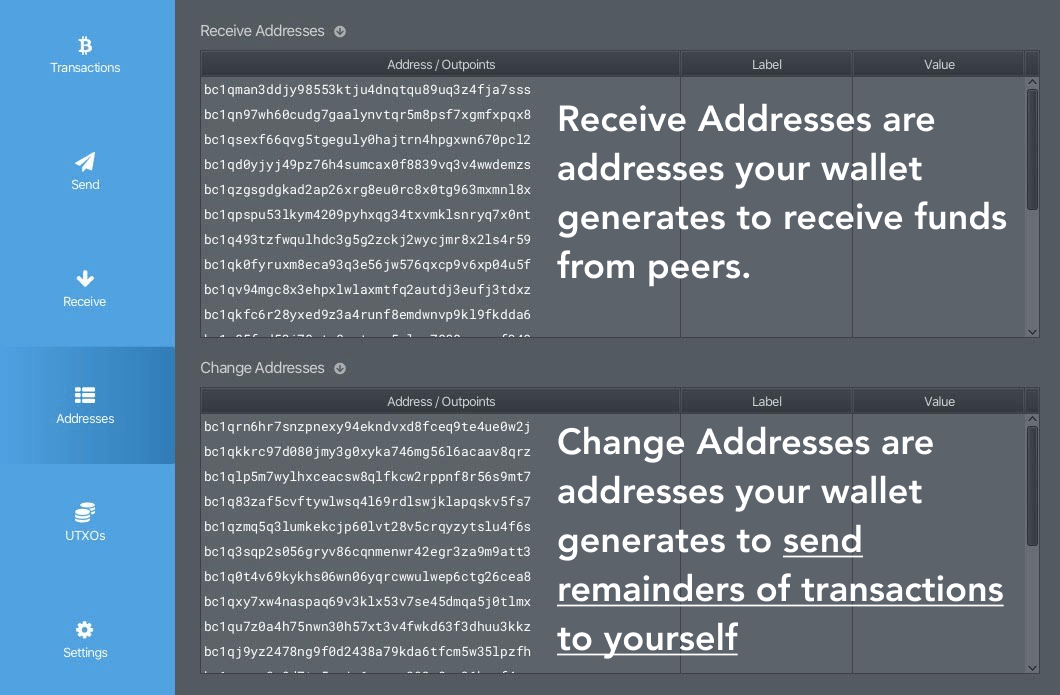
Note that the addresses listed on this screen do not represent all the addresses controlled by this particular wallet. Bitcoin wallet software leverages public and private keys such that wallets are capable of generating over 2 billion unique addresses.
Mobile Wallet Example - River’s Wallet
To locate a Bitcoin address in the River mobile app, input your username and password, and then from the home screen, select the “receive” button in the bottom right corner. The middle screen displays below a Bitcoin address in a QR code format; to reveal the alphanumeric address format, simply tap on the QR code display:
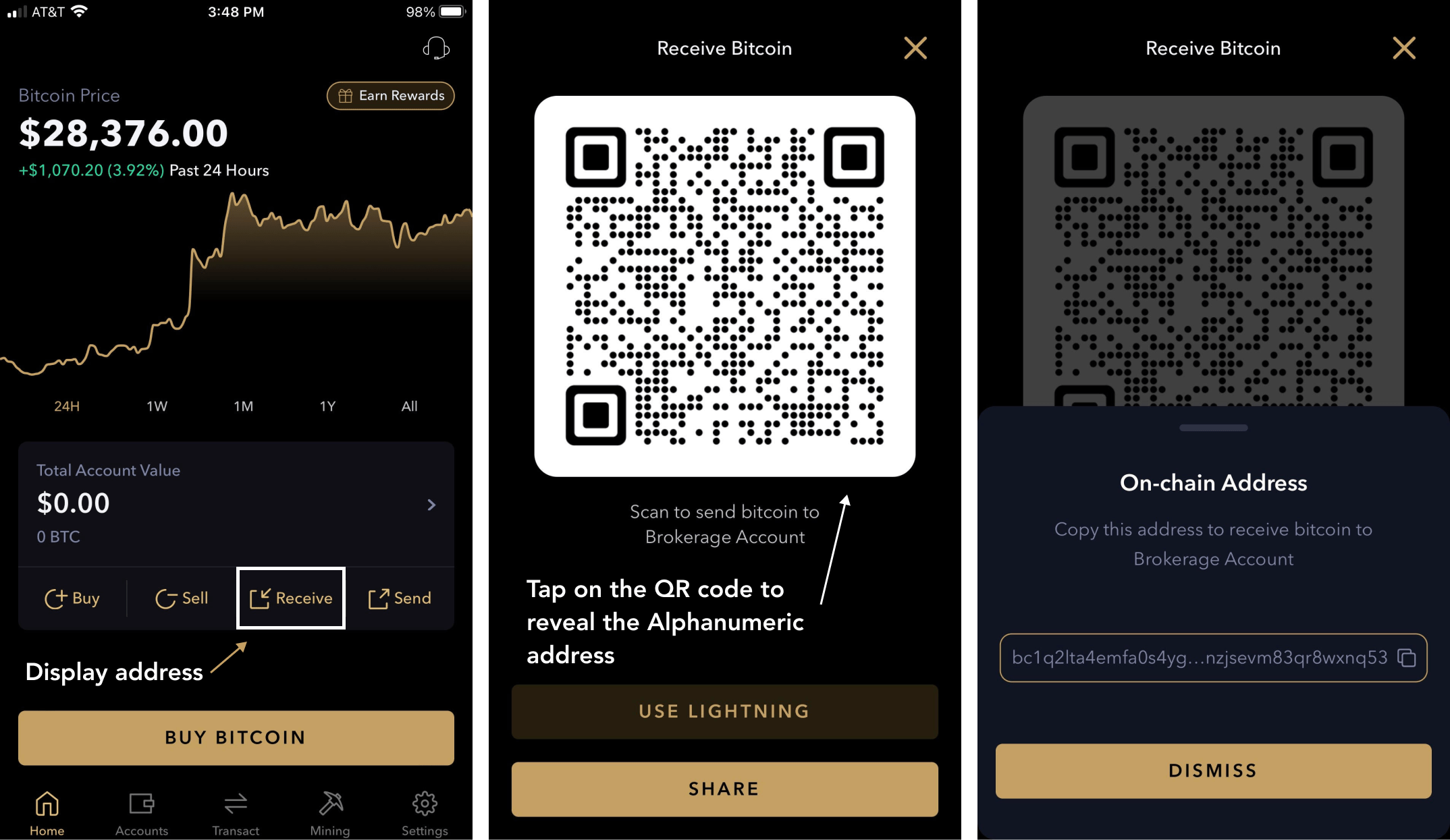
Following this action, a pop-up bar will appear from the bottom of the screen (3rd image on the right) displaying the current receive address as well as an option to copy the address to the device’s clipboard. This feature is handy when users share addresses with their peers.
Types of Bitcoin Addresses
When transacting on the Bitcoin network, it is common to come across addresses that appear different from each other in length or preceding character(s):
- bc1ph4uhh6aqltgukgt7trvrup02vv3cuedcgl32r6w3z6kj2jftsr5qpqchqy
- 3CK4fEwbMP7heJarmU4eqA3sMbVJyEnU3V
- bc1qtelnvxqkc878qgruw2j6e98r56xqxyl77fwkl6
- 18vAScVKCkttNWZAc9SSE8KL2BYVD9WkwK
These differences reflect the ever-changing nature of the Bitcoin network – as more users join the network, and as more features are added, Bitcoin addresses change to support new use cases.
The following table outlines six different Bitcoin address formats, what differentiates them from each other, how to identify different address types using prefixes, and examples of the different address formats and associated transactions.
| Address Type | What is it? | Can I use it today? | Address Prefix | Example Transaction |
|---|---|---|---|---|
| Pay-to-Public-Key (P2PK) | Earliest form of addresses; bitcoin is locked to a user’s public key itself. | No longer supported by the majority of wallets. | N/A | “Satoshi-to-Hal-Finney.” |
| Pay-to-Public-Key-Hash (P2PKH) | Instead of locking bitcoin to the public key, this address format locks funds to a hash of the public key. | Most wallets do not support the format. | P2PKH addresses are denoted by a prefix of “1”: Example |
Laszlo Hanyecz’s “Pizza Day” transaction. |
| Pay-to-Script-Hash (P2SH) | Flexible format that allows users to lock funds to the hash of some Bitcoin script – a specific set of unlocking instructions. | Yes, can be used today in some wallets. | P2SH addresses are denoted by a prefix of “3”: Example |
One of the earliest examples of a P2SH address being used. |
| Pay-to-Witness-Public-Key-Hash (P2WPKH) | Similar to P2PKH in that funds are locked to a public key hash, but this format utilizes the SegWit upgrade. | Yes, widely used today. | P2WPKH addresses are denoted by a prefix of “bc1q”: Example |
This example transaction is from the end of March, 2023. |
| Pay-to-Witness-Script-Hash (P2WSH) | Similar to P2SH in that funds are locked to the hash of some Bitcoin script, but this format utilizes the SegWit upgrade. | Yes, widely used today. | P2WSH addresses are also denoted by a prefix of “bc1q”, but are longer than P2WPKH: Example |
One of the earliest instances of a spend from a P2WSH address. |
| Pay-to-Taproot (P2TR) | This newest Bitcoin address format utilizes the Taproot Upgrade and provides users the customizability of P2SH, with much stronger privacy. | Yes, some modern wallets support P2TR. | P2TR address formats are denoted by a prefix of “bc1p”: Example |
Example transaction in which a SegWit(v1) address (bc1q) spends to a Taproot address (bc1p). |
Bitcoin Address Security
Since Bitcoin uses addresses to keep track of where funds are, the system also needs to ensure that users can never create the same address and accidentally get access to someone else’s funds. By making addresses a long string of letters and numbers, the chances of this happening are virtually impossible. A single Bitcoin wallet can generate billions of unique Bitcoin addresses, and the chances of another user randomly generating the same address are 1 in 1048 – essentially a 0% chance.
Bitcoin Address FAQs
“Is it possible for someone else to generate the same Bitcoin address that I have?”
- The short answer is yes, it is technically possible for another user to generate an identical address to one that your Bitcoin wallet has created. However, according to a series of calculations by Bitcoin developer Andrew Poelstra, the chances of this scenario happening sit at nearly 0% probability.
“What happens if I make a typo when entering an address, and then send bitcoin to the mistaken address?”
- First, Bitcoin addresses have a built-in typo checker, called the checksum: most Bitcoin wallet applications would indicate that the address does not exist (if the typo address actually did not exist). But, let’s say that you entered an incorrect address that did exist? In this case, your funds would be sent to the user who controls the private keys associated with the particular address. Due to the nature of Bitcoin transactions, once funds are sent, there are no rollbacks; everything is final.
“Double-checking a Bitcoin address is correct before sending seems cumbersome, are there any ways to simplify the process?”
- It is important to diligently check Bitcoin addresses before sending or receiving transactions. You can be fairly confident that by matching up the first and last six digits of a Bitcoin address, it is a valid address.
“What happens to my old addresses? Can I still receive bitcoin on them?”
- Old addresses – addresses that have previously been used – can be used again, technically speaking. There is no difference between how a new, and previously used address function. Do not worry if someone sends bitcoin to a previously used address, those funds will still be controlled by your wallet. However, it is best practice to not reuse addresses: receiving multiple coins to the same address indicates to observers that these coins are owned by the same owner.
The Synergy Between Bitcoin Keys, Addresses, and Wallets
If you are still struggling to understand the relation between keys, addresses and wallets, we dive a little bit deeper below.
On the Bitcoin network, users are able to send and receive transactions thanks to public key cryptography – a system in which each user has a public and private key. Those keys allow peers to send encrypted messages to each other, and on Bitcoin, messages are transactions.
➤ Learn more about how Bitcoin uses cryptography.
A Bitcoin address is an alphanumeric string of characters that contains information about a particular user’s public keys.
A Bitcoin wallet is a software application that generates and stores a user’s public and private keys; these keys enable a user to send and receive funds to addresses that are themselves generated from public keys.
What occurs in practice when users send and receive bitcoin to different addresses? Control of bitcoin changes from one set of private keys to another. Wallets do not contain any funds, strictly speaking; Bitcoin wallets generate and manage a user’s public and private keys – and, by extension, addresses.
Bitcoin addresses are a readable form of public keys; the first few characters indicate the type of locking mechanism with which funds are secured. From a user’s perspective, Bitcoin wallets manage different addresses, which is possible because wallets can generate and maintain private keys. Therefore, so long as a user is in control of their private keys – via their wallet of choice – that user remains in control of their Bitcoin addresses, and the funds locked to them.
Key Takeaways
- Bitcoin addresses are places on the Bitcoin blockchain where users can send or receive funds.
- Bitcoin wallets generate bitcoin addresses and manage the funds associated with them.
- The differences in Bitcoin address formats correspond to upgrades that have been made to the network over time.
